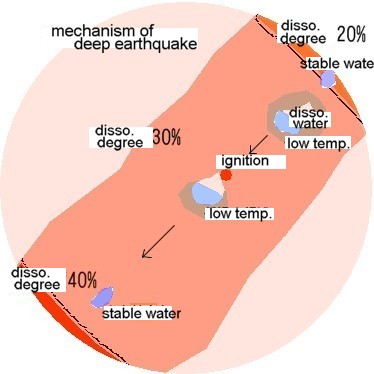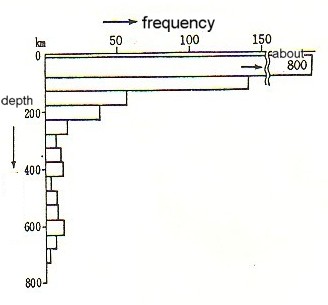| Learning from the seminar of the new seismology |
|||||||||||||||||||||
| WADATI zone doesn't mean the dive phenomenon of the plate | |||||||||||||||||||||
 |
|||||||||||||||||||||
|
Generally, WADATI zone is being explained with meaning the dive phenomenon of the plate in the deep part. A seismic occurrence side is thought to align at the surface of the dive plate. A long movement is finished here, and the ocean plate is thought existence to be finished. In other words, this is the graveyard of the ocean plate. Ishida theory gives it really different interpretation. Fig.1 shows a WADATI zone, and a red point shows the occurrence place of the high depth earthquake. |
|||||||||||||||||||||
| Fig.1 WADATI zone (or, Benioff zone) means the explosion stage of the dissociated water. |
|||||||||||||||||||||
|
According to Ishida theory, this red point means the explosion of the dissociated water carried to the inside of the earth with the convection of mantle. Large quantities of water is included in the inside of mantle due to the big earthquake in the trench part. Levels of a dissociation of this water inside mantle increase caused by rise in temperature. Until a level of a dissociation is 100%, it passes through a process to explain in New-office21, and proceeds in the inside of the earth. An earthquake side appears as some lines because of this. The detailed explanations of the circular part of Fig.1 are the contents of Fig.2. |
|||||||||||||||||||||
| A dissociation begins newly when a level of a dissociation progresses in 30% from 20% of the areas. This detonation gas doesn't ignite right after the dissociation because a circumference becomes a low temperature due to the endothermic reaction. But, when it progresses to the deep place, temperature is recovered, and low temperature areas decrease. A detonation gas explodes in the place to reach ignition temperature. It becomes a stable consolidated water after the explosion, and progresses to the area of a higher level of a dissociation, and the same process is repeated. An explosion i earthquakej doesn't stop until a level of a dissociation is 100%. |
 |
||||||||||||||||||||
| Fig.2 When a level of a dissociation rises, water inside magma dissociates, and circumference temperature decreases. Dissociated water (detonation gas) doesn't ignite at the time of low temperature. When temperature is recovered, it ignites and explodes. It becomes stable water after the earthquake, and it is moved to the inside of the earth more. |
|||||||||||||||||||||
|
The place where a level of a dissociation is 100% is the place where an earthquake occurrence disappears. According to the plate tectonics theory, mantle assimilates by the plate here. But, the interpretation of the plate tectonics theory is wrong. As for the earthquake, the distortion energy of the plate is not a cause. |
|||||||||||||||||||||
|
Of course mantl has heat energy. It has more enormous energy as a detonation gas. According to Ishida theory, magma is the same as mantle. magma has convection like blood inside the earth. Dissociated water can be expressed with the water which stored up enormous energy. It is smaller than a shallow earthquake because the scale of the deep earthquake is a water internal supply type. It has the possibility to become a huge earthquake by the enormous heat in mantle with large quantities of seawater in case of the shallow earthquake which appears on the deep. Though big damage didn't appear in case of a deep earthquake, we didn't know an occurrence mechanism, and that was a mystery. .
|
|||||||||||||||||||||
|
Fig.3 shows the distribution of the depth of the earthquake occurrence point.This figure shows that it happens in the place where most earthquakes are shallower than 100km.Ishida theory presents the second crust layer existence under Moho.This layer is composed of the hard precise peridotite, and it corresponds in the layer named a lithosphere in the plate tectonics theory.A crust in Ishida theory corresponds in the lithosphere. In other words, most earthquakes are an explosion phenomenon inside the crust.The frequency of the deep earthquake is small, and there is a little danger in it. |
 |
||||||||||||||||||||
| Fig.3 The distribution of the deep earthquake occurrence depth . | |||||||||||||||||||||
| BACK | |||||||||||||||||||||